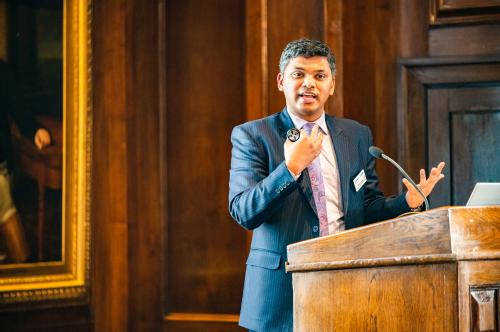WMG News
International experts developed the foundational ISO standard for the safety of self-driving vehicles
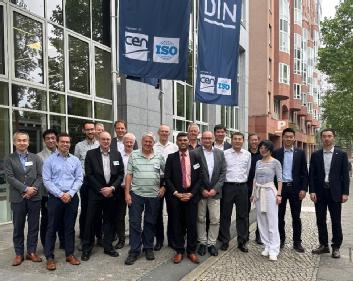 A new international standard has been published which lays the foundations for safe deployment of self-driving vehicles by creating a common approach to define the operating conditions of self-driving vehicles, which is also known as the Operational Design Domain (ODD) (i.e., operating conditions).
A new international standard has been published which lays the foundations for safe deployment of self-driving vehicles by creating a common approach to define the operating conditions of self-driving vehicles, which is also known as the Operational Design Domain (ODD) (i.e., operating conditions).
Led by Professor Siddartha Khastgir from WMG, University of Warwick, UK, and supported by an international group of experts, the very first international standard for safe operation of self-driving vehicles, Road Vehicles — Test scenarios for automated driving systems — Specification for operational design domain – ISO 34503 has been published. This standard will be relevant to every self-driving vehicle developed and manufactured anywhere in the world. The new standard is based on BSI PAS 1883, developed by BSI the UK National Standards Body.
In simplistic terms, ODD is a definition of where your self-driving vehicle is going to operate. This standard provides specifications for defining these operating conditions in a common manner.
The standard classifies ODD into three key categories: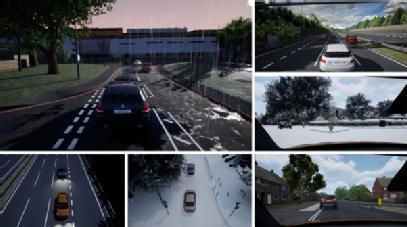
· Scenery elements: non-movable elements (e.g., roads, bridges, traffic lights),
· Environment conditions: weather and other atmospheric conditions; and
· Dynamic elements: all movable objects and actors.
The importance of the concept of ODD is highlighted in the latest European Union’s Act on Automated Driving System (adopted in Aug 2022) which puts the concept of ODD as a cornerstone of the safety assurance process of an automated vehicle. Similar approaches are being considered at the upcoming regulations at United Nations Economic Commission for Europe.
This international standard is a big step to facilitate the commercialisation of self-driving vehicles in a wider global society while also safeguarding the safety of this emerging technology. International organisations and local governments or regulatory agencies can use this standard as a guide to develop their regulations and policies on self-driving vehicles. Autonomous vehicle developers and manufacturers around the world can now design and test their technology based on internationally aligned safety benchmarks, create accurate marketing and communication materials, and build societal trust in the technology.
WMG in collaboration with BSI committee AUE/15 Safety related to vehicles, worked with global partners in countries such as United States, Germany, Japan, China, France, Austria, Canada, Israel, Sweden, Finland, South Korea, Australia, to develop and finalise the ISO standard for the safety of automated vehicles.
Professor Siddartha Khastgir, Head of Verification & Validation, Intelligent Vehicles said:
“Defining the Operational Design Domain is the first step in designing a safe self-driving vehicle. Furthermore, due to the diversity in stakeholders in this ecosystem (e.g., developers, regulators, local authorities etc.), it is essential we have a common way to define such a fundamental concept of safety.
“Successful standardisation efforts are only possible with true international collaboration. I am grateful to experts from various countries worldwide who have engaged and contributed actively to this standard. I am pleased to see more efforts kick-starting which building on the concept of ODD and this standard.”
This standardization activity is underpinned by strong research outcomes from the CCAV and Innovate UK funded OmniCAV research project by WMG; and also, by the research conducted as part of Professor Khastgir’s UKRI Future Leaders Fellowship.
Nick Fleming, Associate Director, Transport and Mobility, BSI said:
“It’s exciting to see the launch of this new international standard, given the potential benefits that can be realized by testing automated vehicles so they can operate safely on our roads. Having a common language to describe the Operational Design Domain (ODD) of an automated vehicle, with the ODD effectively describing the environment and conditions that an automated vehicle is capable of operating in, will be valuable to test and deploy these vehicles safely.
“This new ISO standard has been inspired by the UK document, BSI PAS 1883:2020, the first taxonomy for ODDs developed in conjunction with UK experts and the government’s Centre for Connected and Automated Vehicles (CCAV).
“BSI would like to thank Professor Khastgir for his effort in helping to lead this work at the international level which, along with BSI PAS 1883, shows the leadership the UK is having in the development of global standardization for automated or self-driving vehicles.”
Sarah Gates, Director of Public Policy at Wayve, said:
“We’re pleased to see the launch of this new international standard. The concept of ODDs is the basis of deploying self-driving vehicles safely. A common way of describing ODDs across industry is therefore vital for creating the highest safety standards, bolstering public trust and supporting the regulatory frameworks required to commercially deploy self-driving technology on a global scale.
“We look forward to continuing to work closely with WMG to ensure that safety standards for self-driving technology are rigorous, and to increase confidence in the exciting technology we’re developing here at Wayve, which will unlock a safer, smarter and more sustainable transport system.”
ISO 34503 was developed by ISO technical committee ISO/TC 22/SC 33 Vehicle dynamics, chassis components and driving automation systems testing.
It can be purchased from your national standardisation body or through the ISO Store.
This standardisation activity is underpinned by strong research outcomes from the CCAV and Innovate UK-funded OmniCAV research project by WMG; and also, by the research conducted as part of Professor Khastgir’s UKRI Future Leaders Fellowship.
NOTE TO EDITORS: Link to ISO 34503: https://www.iso.org/standard/78952.html
Media contact: Annie Slinn, Communications Officer (Sciences), Annie.Slinn@warwick.ac.uk | Caitlin Evans, WMG Marketing and Communications Executive, Caitlin.Evans@warwick.ac.uk
Project workshop addresses cyber-security in connected and autonomous mobility
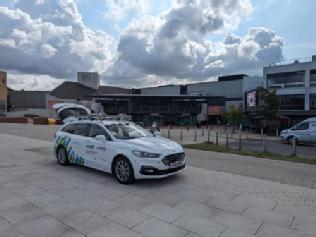 Researchers from WMG, at the University of Warwick, were pleased to welcome partners and guests to a live trial and project workshop on the AirQKD project.
Researchers from WMG, at the University of Warwick, were pleased to welcome partners and guests to a live trial and project workshop on the AirQKD project.
AirQKD addresses the cyber security of Connected and Autonomous Vehicles (CAV) and specifically addresses components, manufacturing, software, and testing for last-mile Quantum Key Distribution (QKD) systems between shared parties for 5G and connected cars.
It is an Innovate UK funded collaboration between BT; Lexden Technologies; OLC; Duality, Bristol University; Fraunhofer Centre for Applied Photonics; Strathclyde University; WMG; Bay Photonics; Heriot Watt University; Angoka; ArQit; Nu Quantum; National Physical Laboratory; CSA Catapult and Edinburgh University.
The trial combines BT’s expertise in building quantum-secure networks using QKD – an essentially un-hackable, cutting-edge technique for sharing encryption ‘keys’ between locations using a stream of single photons) with other new techniques for applying quantum security to mobile devices, developed by UK start-ups Nu Quantum, Angoka and Duality.
On the University of Warwick campus, as part of the Midlands Future Mobility testbed, WMG has created a Vehicle to Infrastructure (V2I) testing facility enabling AirQKD partners’ technology in key management, key consumption, and security protocols to be used for secure communications.
The AirQKD system implements Free Space Optics (FSO) cryptographic key generation and standards-compliant key management. WMG is now managing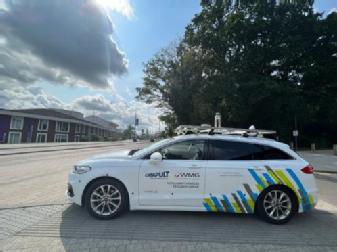 the workstream between telecommunications (4G/5G cellular at BT’s Adastral Park site) and V2I communications on the University of Warwick campus. In combination, these technologies will be used to deliver an ultra-secure link between connected 5G towers and mobile devices, as well as to connected cars.
the workstream between telecommunications (4G/5G cellular at BT’s Adastral Park site) and V2I communications on the University of Warwick campus. In combination, these technologies will be used to deliver an ultra-secure link between connected 5G towers and mobile devices, as well as to connected cars.
Find out more about CAV research at WMG here: https://warwick.ac.uk/fac/sci/wmg/research/cav/connectivity/
Read more about AirQKD here: https://warwick.ac.uk/fac/sci/wmg/research/transformation/securecybersystems/projects
New report outlines the need for cross domain transport safety standards
- New report outlines the need for a Cross Domain Safety Assurance Framework for Automated Systems to ensure the safe introduction of automated transport systems
- Adoption of this framework would enable faster and safer national roll-out of the technologies in the UK, projected to be worth £700 billion globally by 2030
- The findings recommend the need for an industry-government and academia body responsible for safety assurance as well as scenarios available for stakeholders and regulators
- The report calls for a codified set of rules to define safe and acceptable behaviour for automated transport systems as well as a scalable safety assurance framework
A new report launched by WMG, University of Warwick’s Dr Siddartha Khastgir identifies the need for a Cross Domain Safety Assurance Framework to ensure the safe introduction of automated transport systems across land, air and marine.
The report outlines three key building blocks of research, standards, and regulations required for the safety framework: test scenarios, test environment, and safety evidence and safety argument.
The transport sector is worth over £100 billion to the UK economy, but with over 2,000 deaths and over 120,000 injuries every year. Safety remains a key priority.
Connected and autonomous transport, set to be worth over £700 billion by 2030, not only has the potential to make travel safer but also faster and more efficient, contributing to both national health and carbon emissions goals.
To support the development and adoption of a cross-domain safety assurance framework, the findings of the report recommend the need for a government - industry and academia body responsible for safety assurance of autonomous transport systems. This will enable fertilisation of ideas across land, air and marine as each work to solve the same set of research and engineering questions.
The report identifies the need for a centralised scenario library to draw on to support testing to standards. It also highlights the importance of developing a Virtual Test Environment (VTE) for use by regulators as well as a qualification process for VTE and enhancing the UK’s National Digital Twin Programme to realise this. The findings also call for a codified set of rules to define safe and acceptable behaviour for automated transport systems on land, air and sea as well as a scalable safety assurance framework.
Dr Siddartha Khastgir commented: “If we’re serious about the safe introduction of automated transport systems, we need to focus on setting high standards for safety assurance and ensuring we’re not competing on safety. Collaboration will be key to our success.”
“Taking a cross-domain approach to safety assurance offers various opportunities and benefits to the ecosystem. Firstly, it enables us to learn from the strengths of individual (land, air, and sea) domains. Then, on a more practical note, the associated tools, and procedures in implementing the safety assurance framework such as databases and virtual test environments can be used across all domains, making it cost effective. Finally, and importantly, it helps to avoid triplication by translating learnings and helping foster relationships across these traditionally siloed and independent domains – altogether making research and deployment of autonomous transport systems more efficient.”

Andrew McKeran, Business Director, Maritime Performance Services at Lloyd’s Register Group said: “There is a significant opportunity for the UK to be a global leader in maritime autonomy, developing a long term, hi-tech ecosystem.
“From a maritime perspective, we need a robust, reliable and usable global assurance framework for the safe operation of autonomous ships. The result will be confidence in the data, confidence in the decision-making, and confidence in the systems that are needed to exploit the safety and economic benefits that autonomy can bring.”
"We see great opportunity to collaborate with the other sectors, primarily aviation and automotive to learn lessons, mature thinking, and most importantly develop virtual test environment capabilities for maritime technology applications.”
Michael Gadd, Head of Airworthiness, Blue Bear commented: “Aviation has a global perspective and within this sector the UK has considerable innovative capabilities and technologies. These advancements are supported by pioneering safety and regulatory frameworks which continually install the trust and confidence that enables the economic benefits the sector delivers, from leading-edge research and development to the wide range of aircraft operations and everything in between.
“The development of a cross-sector safety assurance framework will empower the wider sharing of experience and best practices and help deliver the tools and techniques that are necessary to build confidence and trust in high authority automation and autonomous systems in a common way irrespective of the end use case.”
“This collaborative approach between sectors will develop key skills and knowledge whilst accelerating the assurance process to deliver demonstrably safe products to market, maximising opportunities for economic growth and also developing experience-based leadership in a globally competitive area.”
To read the full report, please visit: https://warwick.ac.uk/fac/sci/wmg/research/cav/vandv/ukriflf/cross_domain_safety_assurance_framework_for_automated_systems.pdf
ENDS
NOTES TO EDITORS
About WMG, University of Warwick
WMG is a world leading research and education group, transforming organisations and driving innovation through a unique combination of collaborative research and development, and pioneering education programmes.
As an international role model for successful partnerships between academia and the private and public sectors, WMG develops advancements nationally and globally, in applied science, technology and engineering, to deliver real impact to economic growth, society and the environment.
WMG’s education programmes focus on lifelong learning of the brightest talent, from the WMG Academies for Young Engineers, degree apprenticeships, undergraduate and postgraduate, through to professional programmes.
An academic department of the University of Warwick, and a centre for the HVM Catapult, WMG was founded by the late Professor Lord Kumar Bhattacharyya in 1980 to help reinvigorate UK manufacturing and improve competitiveness through innovation and skills development.
WMG has been successfully leading and participating in national and international collaborations such as OmniCAV, Midlands Future Mobility, Safety PoolTM Scenario Database as well as working on CCAV and Innovate UK funded Collaborative R&D projects. WMG’s research is helping to influence international standards and regulations with active participation at ISO, ASAM, SAE and UNECE forums.
PHOTO CAPTIONS (hi res available on request):
1. Dr Siddartha KhastgirLink opens in a new windowLink opens in a new window presents his report
2.L to R: Prof Paul Jennings, Research Director at WMG; Sarah Gates, Wayve; Andre Burgess, National Physical Laboratory; Andrew Macmillan, Vertical Aerospace; Michael Gadd, Blue Bear; Jane Fenn, BAE Systems; Ali Chegini, RSSB; Dr Siddartha Khastgir, WMG.
CONTACT
Sheila Kiggins
Media Relations Manager
University of Warwick
07876 218166
Partnership between WMG and The Blair Project to deliver electrification skills training in the north

WMG has partnered with The Blair Project, a social enterprise based in Manchester, to deliver the Emerging Skills Project in the north, a programme funded by the Department for Education (DfE).
The Emerging Skills Project will create a highly skilled workforce that will enable industries including automotive, energy and food and drink, to take advantage of electrification and hydrogen-power to deliver Net Zero.
The course provided by The Blair Project will specifically address technologies related to electric vehicles. This will include the assembly and maintenance of battery modules and packs, recycling and second life, the manufacturing and installation of motors, drives and power electronics and the designing and testing of vehicle and software systems.
Developed in conjunction with businesses who were invited to a series of workshops with DfE, the course will directly respond to the demand for wider adoption and deployment of transport electrification technologies.
The course will be held at the new Manchester Innovation Activities Hub (MIAH) – launching in Spring 2022. Dedicated to the rapid upskilling, reskilling and retraining of more than 5,000 local residents over the next five years, MIAH is set to become a centre of excellence in Greater Manchester and a hub for electrification skills training in the north.
Ben Silverstone, Associate Professor and Head of WMG Skills Centre, said:
“As important as it is to train up the younger workforce in green tech, there is a significant workforce primed for reskilling now. It’s the combination of both that will ensure we are well-equipped to meet the UK’s ambitious Net Zero targets.
“We are pleased to partner with an organisation like The Blair Project to deliver the Emerging Skills Project, meeting the UK-wide demand for electrification skills and giving people in the region the opportunity to upskill or reskill in this area.”
Nile Henry, Founder and CEO of The Blair Project, said:
“The UK is facing a huge skills gap in green tech, particularly electrification, and this is only set to increase as we power towards Net Zero and the demand for a highly skilled workforce grows. Partnering with WMG to become a delivery partner for the Emerging Skills Project is a huge milestone for The Blair Project, and it’s brilliant to see this focus from Government on upskilling adults in green tech.”
WMG academic joins Department for Transport’s Science Advisory Council
· Dr Siddartha Khastgir, from WMG at the University of Warwick has been appointed to be on the Department for Transport’s Science Advisory Council (SAC).
· The DfT Science Advisory Council (SAC) provides independent strategic advice and challenge to the Department on key areas of science, social science engineering and technology.
· Dr Khastgir will focus on taking a systems thinking approach across various modes of transport (land, air and marine) to ensure their safe enrolment and public acceptance in the UK
Dr Siddartha Khastgir from WMG, University of Warwick, has been appointed to be on the DfT’s Science Advisory Council, where he will advise on a wide range of science and engineering issues, such as enrolment of Autonomous Vehicles.
advise on a wide range of science and engineering issues, such as enrolment of Autonomous Vehicles.
Today, Friday 14th January 2022, the Department for Transport have announced five new members and a new Chair joining their Science Advisory Council, including Dr Siddartha Khastgir from WMG, University of Warwick.
The DfT’s Science Advisory Council provide the DfT with advice and challenge on key areas of science, engineering and technology, supporting the role for the DfT Chief Scientific Adviser Professor Sarah Sharples, by ensuring departmental activity is informed by the best external expertise and evidence, identifying relevant emerging issues and trends and assuring DfT’s use of science and technology.
Dr Siddartha Khastgir is Head of Verification and Validation of Connected and Autonomous Vehicles at WMG, University of Warwick. In 2019 he was awarded a UKRI Future Leader Fellowship focusing on Autonomous Vehicle safety standards. Leveraging his research on Autonomous Vehicles safety, he will focus on taking a cross-domain approach to safety in land, marine and air.
With his new appointment on the council Dr Khastgir will help advise DfT on the technological and societal challenges surrounding introduction of new technologies, and how they can be enrolled in UK safely and efficiently. He comments:
“To be a part of the Department for Transport’s Science Advisory Council is incredibly exciting, I’m looking forward to working with other experts in the field to provide advice to help the DfT to inform future policy, with its foundations in strong research outputs. Not only do we need to create safe systems, we need to communicate with the public to ensure public acceptance.”
Margot James, Executive Chair at WMG, University of Warwick adds “I am delighted to hear that Siddartha has been appointed to the Department for Transport Science Advisory Council, a reflection of his world-leading research into safety for connected and autonomous vehicles. I will be watching with interest to see how the DfT moves this emerging technology forward, and look forward to Siddartha being a key part of this.”
UKRI Future Leaders Fellowships Director Stephen Meader said:
“The world leading research undertaken by Dr Khastgir and his team is vital for the development of safe autonomous vehicles that can cut both congestion and carbon emissions.
“Dr Khasgir’s appointment to the Department for Transport’s Science Advisory Council (SAC) demonstrates both the importance of this work to the future of mobility in the UK and the value the Future Leaders Fellowships scheme brings in enabling his research.”
Other new appointees joining six existing members include:
· Dr Siddartha Khastgir, Head of Verification and Validation of Connected and Autonomous Vehicles, University of Warwick
· (SAC Chair) Professor Alastair Lewis, Professor of Atmospheric Chemistry, University of York
· James Gaade, Head of Programme Management, The Faraday Institution
· Professor William Powrie, Professor of Geotechnical Engineering, University of Southampton
· Dr Emma Taylor, Head of Digital Safety, RazorSecure Ltd.
· Professor Patricia Thornley, Director of the Energy & Bioproducts Research Institute, Aston University
Department for Transport Chief Scientific Adviser, Sarah Sharples, said: “I’m pleased to welcome the new members appointed to the Science Advisory Council. They bring significant additional expertise in key areas that will support DfT’s effective use of science and engineering. I look forward to working with them.”
ENDS
14TH JANUARY 2022
NOTES TO EDITORS
High-res images available at: https://warwick.ac.uk/services/communications/medialibrary/images/april2020/sid_39.jpg
Caption: Dr Siddartha Khastgir, from WMG, University of Warwick
Credit: WMG, University of Warwick
For further information please contact:
Alice Scott
Media Relations Manager – Science
University of Warwick
Tel: +44 (0) 7920 531 221
E-mail: alice.j.scott@warwick.ac.uk
China welcomes world’s largest scenario database for autonomous vehicle safety
- Safety Pool™, led by WMG at the University of Warwick and Deepen AI, launches major collaboration with Automotive Data of China (CATARC-ADC), a subsidiary of CATARC Co., Ltd, bringing world’s largest public database for testing autonomous vehicle safety to China
- The database provides diverse sets of road safety scenarios, so that autonomous vehicles can be rigorously tested on virtual simulations of real public routes – this will now include Chinese use cases
- Over 200 organisations worldwide have already enrolled in Safety Pool™; greater collaboration advances the autonomous vehicle industry and further enhances road safety globally
The Safety PoolTM Scenario Database, the largest public repository of scenarios for testing autonomous vehicles in the world — led by WMG at the University of Warwick and Deepen AI — will now be used in China, thanks to a new partnership with Automotive Data of China, a subsidiary of the China Automotive Technology and Research Center (CATARC-ADC).
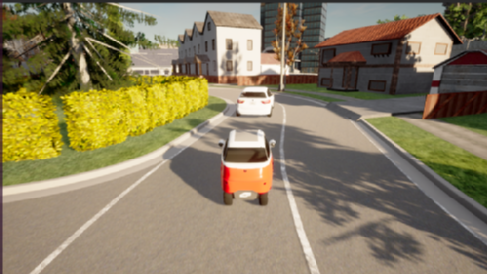
CATARC-ADC is China’s principal research and technical organisation for the automotive industry, and is at the cutting edge of the country’s innovation and regulation for connected and autonomous vehicles (CAV). Meanwhile, CATARC-ADC actively participates in ISO, ASAM and UNECE and other international organizations, with international influence.
This significant new major collaboration, launched today (9 September 2021), means that Safety Pool™ Scenario Databases will enable road simulations including use cases from China, broadening the scope of this global safety platform – thus supporting the growing CAV industry, informing emerging regulatory policies, and enhancing the safety of millions more drivers across China and beyond.
Dr Siddartha Khastgir, Head of Verification & Validation, Intelligent Vehicles at WMG, University of Warwick, said:
“Safety of Autonomous Vehicles needs to be a collaborative mission. No one organisation or country can achieve this mission on their own. With this in mind we created Safety PoolTM Scenario Database to enable global collaboration on scenario sharing.
We are delighted that CATARC-ADC have joined Safety PoolTM Scenario Database which reinforces our mission of international collaboration on CAV safety. With a diverse set of scenarios, the database caters to a large number of autonomous vehicle applications, many of which will be relevant for our stakeholders in China.”
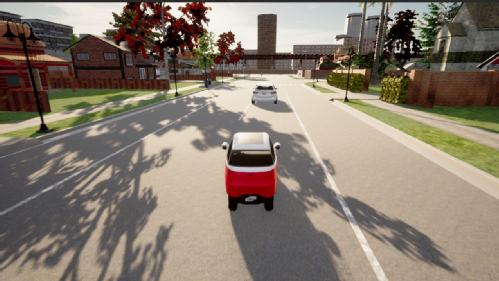 Nicola Croce, Technical Program Manager, Deepen AI, said:
Nicola Croce, Technical Program Manager, Deepen AI, said:
“Safety Pool™ has all the ingredients to be the reference platform and initiative for AV safety assurance worldwide. What's very unique about it is its global scope, the incentive-based mechanisms engineered to attract and provide value to every different industry stakeholder, and the deep engagement with regulators, everything based on a common foundation of data sharing.
We are excited to welcome CATARC-ADC to the Safety Pool initiative. CATARC-ADC is the major player in scenario-based testing and scenario databases in China. CATARC-ADC’s entry into Safety Pool™ provides a key stepping stone in international collaborations in the scenario-based testing landscape of AVs, and a major leap forward to help companies improve their adaptability in China-oriented testing for ADS.”
Since the launch of this pioneering project in March 2021, WMG at the University of Warwick and Deepen AI have collaborated with stakeholders around the world: to date, over 200 organisations have enrolled in the Safety PoolTM Scenario Database
Bolin Zhou, Global Business General Manager, CATARC – ADC said:
“As a founding member of Safety PoolTM Scenario Database in China and the leading third-party company for ADS validation in China, Automotive Data of China will use the great opportunity of Safety PoolTM Scenario Database to tackle the global autonomous vehicle safety issues with its own strength. Safety PoolTM Scenario Database is a crucial, open platform that aligns well with ADC positioning in China and around the world. Through Safety PoolTM Scenario Database, a global safety tool, China will continue to provide data and tool services for automated driving system validation”
Tim Dawkins, Global Impact Strategy Lead, World Economic Forum said:
“Initiatives like Safety Pool are key to making safe autonomous vehicles a reality – we should not be making safety a competitive advantage. This shared scenario library will allow developers to learn from one another’s datasets to increase the robustness of their systems through exposure to a diverse scenario set. CATARC’s support for Safety Pool represents a vital commitment to a level playing field for the development of autonomous vehicles in the name of safety”
Richard Morris, Innovation Lead - Autonomous & Connected Vehicles, Innovate UK said:
“Innovate UK is glad to have supported the creation and the development of the Safety PoolTM Scenario Database. We would also like to encourage more organisations and countries to contribute scenario content. Scenarios kept in private siloes will not help the mass acceptance of vehicle automation. We all need to share safety knowledge and make best practice widely available. The more comprehensive the Safety PoolTM Scenario Database becomes, the more useful it is for any developer wanting to deploy CAVs anywhere around the world.”
The database provides a diverse set of scenarios in different operational design domains (ODDs i.e. operating conditions) that can be leveraged by governments, industry and academia alike to test and benchmark Automated Driving Systems (ADSs) and use insights to inform policy and regulatory guidelines.
The scenarios have been generated using a novel hybrid methodology developed by WMG, at the University of Warwick, using both knowledge-based and data-based approaches. The Safety Pool™ Scenario Database allows organisations to create scenarios in their own libraries, collaborate with other organisations via both shared and public libraries and enable the public to submit challenging real-world scenarios.
Enabling scenarios to be matched to specific environments and operating conditions means that trials and tests can be undertaken in the simulated environment, controlled test facilities and on public roads, with evidence from each environment being used to inform our understanding of safe behaviours, bringing Autonomous Vehicles closer to market at pace.
It has been suggested that in order for CAV to be safe for the average driver, they will need to be tested on 11 billion miles of road – an insurmountable goal in the physical world. The Safety Pool™ scenario based virtual simulations not only offer the necessary quantity of testing, but also the complexity and quality of countless ‘real-world’ road scenarios.
The development of the Safety Pool™ Scenario Database was funded by UK’s Centre for Connected & Autonomous Vehicles (CCAV), Innovate UK and Zenzic funded Midlands Future Mobility project led by WMG, University of Warwick.

